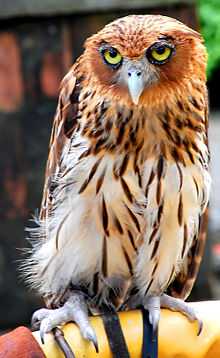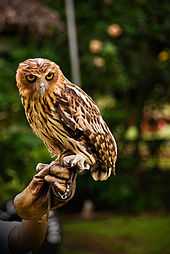Philippine eagle-owl
| Philippine eagle-owl | |
|---|---|
 | |
| At Avilon Zoo, Rodriguez, Rizal, Philippines | |
| Conservation status | |
| Scientific classification | |
| Kingdom: | Animalia |
| Phylum: | Chordata |
| Class: | Aves |
| Order: | Strigiformes |
| Family: | Strigidae |
| Genus: | Bubo |
| Species: | B. philippensis |
| Binomial name | |
| Bubo philippensis Kaup, 1851 | |
The Philippine eagle-owl (Bubo philippensis) is a vulnerable species of bird belonging to the Strigidae family. It is endemic to the Philippines, where found in lowland forests on the islands of Catanduanes, Samar, Bohol, Mindanao, Luzon, Leyte and possibly Sibuyan.[2] It is known locally as the “kuwago” or “bukao”.
Taxonomy
There are two subspecies:
- Bubo philippensis philippensis - Luzon and Catanduanes
- Bubo philippensis mindanensis - Mindanao, Leyte, Samar and Bohol. Darker and more heavily streaked than the nominate.[3]
Description

With a total length of 40–50 cm (16–20 in) and a wing-length of about 35 cm (14 in), it is the largest owl in the Philippines, but among the smallest members of the genus Bubo.[3][4] It is overall rufous with a lighter belly and yellow eyes.
Habitat
This owl inhabits forest edges near streams. They rest in a tree the day and hunts at dusk to feed on small vertebrates. The Philippine eagle-owl is the largest owl in the country.[5]
Behavior
Little is known about the behavior of this secretive species, but the powerful feet suggest it feeds on small mammals and birds.[3]
This eagle-owl lays one egg per clutch and has an incubation period of 35 days.[6]
Breeding in captivity
In December 2005, Negros Forests and Ecological Foundation (NFEFI) in Bacolod City was the first conservation center in the world to successfully hatch a Philippine eagle-owl (aptly nicknamed Bubo) in captivity and it has the only breeding pair of these owls in captivity anywhere in the world.
On November 21, 2005, conservationists at the center made world history when it successfully bred in captivity a Philippine eagle-owl. Notably NFEFI had first secured the first-ever captive breeding loan between DENR-accredited institutions in the Philippines, consisting of three pairs of eagle-owls from the Avilon Montalban Zoological Park in Montalban, Rizal and transported them to Bacolod City in December 2002. Two pairs showed attraction, and the couple “Hinahon” and “Suplada,”—local term for “calm” and “snob”—made courtship. It was on November 21, 2005, that an owlet was discovered in the nest, about three days old, and named “Bubo.” As Bubo grew, Suplada taught it how to tear pieces of mouse meat, thus rearing it.
In 2006, Suplada also laid one egg and another owlet was hatched through the aid of the World Owl Trust, Flora and Fauna International-Philippine Biodiversity Conservation program and the Avilon Zoological Park in Montalban Rizal.[7]
References
- ↑ BirdLife International (2013). "Bubo philippensis". IUCN Red List of Threatened Species. Version 2013.2. International Union for Conservation of Nature. Retrieved 26 November 2013.
- ↑ Philippine Eagle-Owl. BirdLife International Factsheet. Accessed 2008-10-05.
- ↑ 3.0 3.1 3.2 Züchner, T. (1999). Philippine Eagle-Owl (Bubo philippinensis). Pp 192-193 in: del Hoyo, J., Elliott, A., & Sargatal, J. eds. (1999). Handbook of the Birds of the World. Vol. 5. Barn-owls to Hummingbirds. Lynx Edicions, Barcelona. ISBN 84-87334-25-3
- ↑ Kennedy, R., Gonzales, P., Dickinson, E., Miranda, H., Jr., & Fisher, T. (2000). A Guide to the Birds of the Philippines. Oxford University Press, New York. ISBN 0-19-854668-8
- ↑ Avilon Zoo, http://www.avilonzoo.com.ph
- ↑ DED, The DED in the Philippines
- ↑ Visayan Star, Rare owl lays egg
